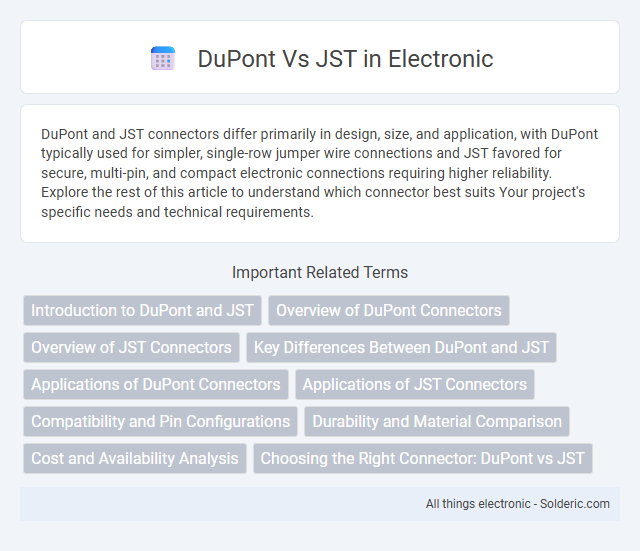DuPont and JST connectors differ primarily in design, size, and application, with DuPont typically used for simpler, single-row jumper wire connections and JST favored for secure, multi-pin, and compact electronic connections requiring higher reliability. Explore the rest of this article to understand which connector best suits Your project's specific needs and technical requirements.
Comparison Table
| Feature | DuPont Connectors | JST Connectors |
|---|---|---|
| Connector Type | Single-row, female pin headers, often used in prototyping and jumper wires | Variety of pin headers, including single and multi-row; commonly used in compact electronic devices |
| Pin Pitch | 2.54 mm (0.1 inch) | Typically 1.0 mm to 2.54 mm, depending on model |
| Usage | Prototyping, jumper wires, breadboard connections | Permanent PCB connections, wire-to-board applications |
| Durability | Lower durability, ideal for temporary connections | Higher durability and secure locking mechanism for long-term use |
| Locking Mechanism | None, friction fit | Often includes locking tabs or latches for secure connection |
| Cost | Low cost, widely available | Moderate cost, higher quality |
| Applications | Arduino, Raspberry Pi prototyping, general DIY electronics | Consumer electronics, automotive, industrial equipment |
Introduction to DuPont and JST
DuPont is a global leader in advanced materials and chemical solutions, known for its innovation in electronics, automotive, and industrial markets. JST (Japan Solderless Terminal) specializes in high-quality electronic connectors widely used in consumer electronics, automotive, and telecommunications industries. Understanding the unique strengths of DuPont's material science and JST's precision connector technology can enhance Your choices in electronic component sourcing.
Overview of DuPont Connectors
DuPont connectors, known for their versatility in prototyping and small-scale electronics, feature a simple single-row, female-to-male design that allows easy customization with jumper wires. These connectors provide reliable low-current connections, commonly used in Arduino, Raspberry Pi, and breadboard setups. You can quickly create flexible circuit connections, making DuPont connectors ideal for rapid development and testing in various electronic projects.
Overview of JST Connectors
JST connectors consist of a variety of reliable, compact wiring interconnects designed for electronic applications, including housing, crimp terminals, and complete connector assemblies. Their products are widely recognized for precision, durability, and compatibility with different wire gauges, ensuring secure electrical connections in consumer electronics, automotive, and industrial devices. You can expect JST connectors to deliver efficient and cost-effective solutions that meet diverse connectivity requirements compared to DuPont connectors.
Key Differences Between DuPont and JST
DuPont connectors are renowned for their simple, single-row housing design suited for breadboarding and prototyping, whereas JST connectors feature compact, multi-row configurations optimized for permanent, space-saving PCB connections. DuPont connectors typically have larger pitch sizes around 2.54 mm making them easier to handle but less suitable for high-density applications, while JST connectors offer smaller pitches such as 1.25 mm or 2.0 mm, enabling more compact circuit designs. Durability also varies with JST connectors generally providing more secure locking mechanisms and better resistance to vibration compared to the straightforward friction fit style of DuPont connectors.
Applications of DuPont Connectors
DuPont connectors are widely used in low-power, low-frequency electronic applications such as prototyping, Arduino projects, and DIY electronics due to their ease of use and reliable signal transmission. These connectors are ideal for connecting sensors, microcontrollers, and other components in compact electronic circuits where space and flexibility are crucial. Your projects benefit from DuPont's versatile design, allowing quick and secure connections without soldering, making them perfect for rapid development and testing.
Applications of JST Connectors
JST connectors excel in compact electronic device applications such as drones, wearables, and robotics due to their lightweight, small footprint, and ease of use. Their reliable connections support intricate wiring systems in consumer electronics, automotive dashboards, and LED lighting setups. You benefit from JST connectors' versatility in environments requiring secure, high-density electrical connections with minimal space.
Compatibility and Pin Configurations
DuPont and JST connectors differ significantly in compatibility and pin configurations; DuPont connectors are known for their universal 2.54mm pitch spacing and single-pin design, making them ideal for prototyping and breadboarding. JST connectors, such as the common PH or XH series, feature more compact and specialized pin arrangements that ensure secure connections in permanent or space-constrained applications. Understanding these differences helps you select the right connector type for reliable electrical connections in various electronics projects.
Durability and Material Comparison
DuPont connectors are known for their robust nylon housing and gold-plated contacts, offering excellent resistance to corrosion and mechanical wear, which enhances long-term durability in various electronic applications. JST connectors utilize high-quality plastic materials such as PBT (polybutylene terephthalate) and also feature gold or tin plating on contacts, providing reliable conductivity and strong resistance to environmental stress. Material choice between DuPont's flexible but durable plastics and JST's rigid, heat-resistant polymers often influences connector performance depending on the specific application requirements.
Cost and Availability Analysis
DuPont connectors generally offer higher durability and performance but come at a premium price, making them less favorable for budget-sensitive projects. JST connectors provide a cost-effective alternative with widely available models suitable for various consumer and industrial applications. Availability of JST connectors is more extensive due to numerous manufacturers producing compatible options, whereas DuPont parts are more limited and specialized.
Choosing the Right Connector: DuPont vs JST
When choosing the right connector, DuPont connectors offer easy prototyping with their single-pin design and compatibility with breadboards, ideal for DIY electronics and quick setups. JST connectors provide a more secure, reliable connection with locking mechanisms, making them suitable for permanent installations and devices requiring stable electrical contact. Your selection depends on whether you prioritize convenience and flexibility or durability and safety in your electronic projects.
DuPont vs JST Infographic

 solderic.com
solderic.com